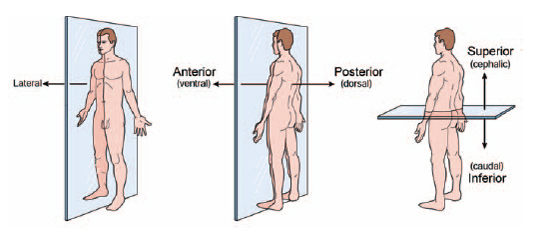Standard directional terms are used to describe the location of one body part in relation to another body part. Most directional terms occur as pairs with one term of the pair having the opposite meaning of the other term.
| Term |
Definition |
Example |
| Superior (cranial or cephalic) |
Toward the head |
The head is superior to the neck |
| Inferior (caudal) |
Away from the head; toward the feet |
The neck is inferior to the head |
| Anterior (ventral) |
Toward the front |
The toes are anterior to the heel |
| Posterior (dorsal) |
Toward the back |
The heel is posterior to the toes |
| Medial |
Toward the midline of the body |
The nose is medial to the eyes |
| Lateral |
Away from the midline of the body; towards the sides |
The eyes are lateral to the nose |
| Proximal |
Toward the trunk of the body; nearer the attachment of an extremity to the trunk |
The shoulder is proximal to the elbow |
| Distal |
Away from the trunk of the body; further from the attachment of an extremity to the trunk |
The wrist is distal to the shoulder |
| Superficial (external) |
Near the surface of the body |
The skin is superficial to the muscles |
| Deep (internal) |
Farther from the surface of the body |
The heart is deeper than the ribs |

Doctors and others who study anatomy divide the human form into several directional planes to help them describe parts of the body. (From Willis, M.C. Medical Terminology: A Programmed Learning Approach to the Language of Health Care. Baltimore: Lippincott, Williams & Wilkins, 2002.)

